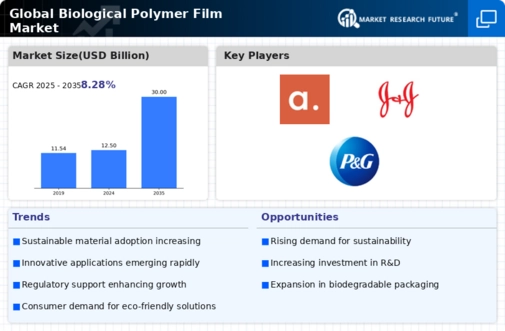Market Growth Projections
The Global Biological Polymer Film Market Industry is poised for substantial growth, with projections indicating a market value of 12.5 USD Billion in 2024 and an anticipated increase to 30 USD Billion by 2035. This growth trajectory suggests a compound annual growth rate of 8.28% from 2025 to 2035. Such figures underscore the increasing adoption of biological polymer films across various sectors, driven by sustainability trends and regulatory support. The market's expansion reflects a broader shift towards environmentally friendly materials, indicating a promising future for stakeholders involved in the production and application of biological polymer films.
Diverse Applications Across Industries
The versatility of biological polymer films across diverse industries significantly contributes to the growth of the Global Biological Polymer Film Market Industry. These films find applications in sectors such as food packaging, agriculture, and healthcare, where their biodegradable properties are highly valued. For example, in the food industry, biological films are used to extend shelf life while minimizing environmental impact. The expanding range of applications indicates a robust market potential, with projections suggesting a market value of 30 USD Billion by 2035. This diversity not only enhances market resilience but also attracts investments aimed at exploring new applications for biological polymer films.
Rising Demand for Sustainable Packaging
The Global Biological Polymer Film Market Industry experiences a surge in demand for sustainable packaging solutions. As consumers increasingly prioritize eco-friendly products, manufacturers are compelled to innovate. Biological polymer films, derived from renewable resources, offer a biodegradable alternative to traditional plastics. This shift aligns with global sustainability goals, as evidenced by the projected market value of 12.5 USD Billion in 2024. Companies are adopting these materials to enhance their brand image and meet regulatory requirements, which further propels market growth. The increasing awareness of environmental issues among consumers and businesses alike indicates a robust trajectory for the Global Biological Polymer Film Market.
Growing Awareness of Environmental Impact
The growing awareness of environmental impact among consumers is a key driver for the Global Biological Polymer Film Market Industry. As individuals become more informed about the detrimental effects of plastic pollution, there is a marked shift towards sustainable alternatives. Biological polymer films, which offer a biodegradable solution, are increasingly favored in various applications, including food packaging and agricultural films. This heightened awareness is reflected in the market's projected growth, with an expected value of 12.5 USD Billion in 2024. Companies that prioritize sustainability in their product offerings are likely to gain a competitive edge, further fueling the demand for biological polymer films.
Technological Advancements in Film Production
Technological advancements play a pivotal role in the Global Biological Polymer Film Market Industry. Innovations in production processes, such as improved extrusion techniques and enhanced material formulations, contribute to the development of high-performance biological films. These advancements not only improve the mechanical properties of the films but also expand their applications across various sectors, including food packaging and medical supplies. As a result, the market is expected to grow significantly, with a projected value of 30 USD Billion by 2035. The continuous evolution of technology suggests that manufacturers will likely invest in research and development to maintain competitiveness in this dynamic market.
Government Regulations Favoring Biodegradable Materials
Government regulations increasingly favor the use of biodegradable materials, significantly impacting the Global Biological Polymer Film Market Industry. Many countries are implementing stringent policies aimed at reducing plastic waste and promoting sustainable alternatives. For instance, regulations that mandate the use of biodegradable packaging in specific sectors create a favorable environment for biological polymer films. This regulatory push is expected to drive market growth, as companies seek compliance while enhancing their sustainability profiles. The anticipated compound annual growth rate of 8.28% from 2025 to 2035 reflects the potential for expansion in this sector, driven by supportive government initiatives.




